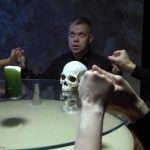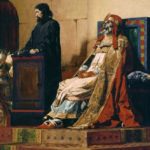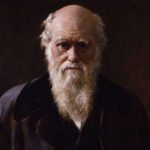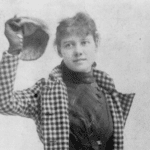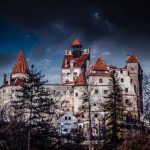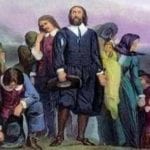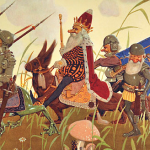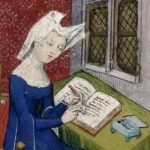 Music
Music  Music
Music  History
History 10 Less Than Jolly Events That Occurred on December 25
 Weird Stuff
Weird Stuff 10 Funny Ways That Researchers Overthink Christmas
 Politics
Politics 10 Political Scandals That Sent Crowds Into the Streets
 Weird Stuff
Weird Stuff Ten Bizarre Facts About The Doge Meme
 Our World
Our World 10 Ways Your Christmas Tree Is More Lit Than You Think
 Movies and TV
Movies and TV The 10 Coolest Stars to Set Sail on The Love Boat
 History
History 10 Things You Didn’t Know About the American National Anthem
 Technology
Technology Top 10 Everyday Tech Buzzwords That Hide a Darker Past
 Humans
Humans 10 Everyday Human Behaviors That Are Actually Survival Instincts
 Music
Music 10 Surprising Origin Stories of Your Favorite Holiday Songs
 History
History 10 Less Than Jolly Events That Occurred on December 25
 Weird Stuff
Weird Stuff 10 Funny Ways That Researchers Overthink Christmas
Who's Behind Listverse?

Jamie Frater
Head Editor
Jamie founded Listverse due to an insatiable desire to share fascinating, obscure, and bizarre facts. He has been a guest speaker on numerous national radio and television stations and is a five time published author.
More About Us Politics
Politics 10 Political Scandals That Sent Crowds Into the Streets
 Weird Stuff
Weird Stuff Ten Bizarre Facts About The Doge Meme
 Our World
Our World 10 Ways Your Christmas Tree Is More Lit Than You Think
 Movies and TV
Movies and TV The 10 Coolest Stars to Set Sail on The Love Boat
 History
History 10 Things You Didn’t Know About the American National Anthem
 Technology
Technology Top 10 Everyday Tech Buzzwords That Hide a Darker Past
 Humans
Humans 10 Everyday Human Behaviors That Are Actually Survival Instincts
10 Tales about Historical Figures and Their Living Descendants
Many people can trace their roots back to a famous figure. But some are on a mission to fix misconceptions about their ancestors—like in the cases of Sitting Bull and Rosa Parks. Also, discover what Hitler’s great-nephews are up to, which Charles Dickens descendant was in Game of Thrones, and why Dante’s family is demanding justice.
Related: Top 10 Deadliest Families in History
10 Jane Austen’s Successful Niece
Jane Austen was a master of English literature, and she lived and wrote in Chawton House. Incredibly, her family continued to live at the now-famous public building until modern times. The last generation to grow up at Chawton House was Caroline Knight, Jane Austen’s fifth great-niece.
Knight shared the same walks, family traditions, furniture, rooms, dinnerware, and family library as Austen. Her grandfather was the 15th Squire of Chawton, and when he passed away, the family couldn’t keep the home. Knight moved out at age 18, ending 400 years of Austen descendants living at the estates.
Knight has always thought highly of her “aunt” but she never coasted on Austen’s fame to achieve success in her own life. Knight worked hard and thrived in business and entrepreneurship, was the CEO of a large company, and more. In 2012, she became an honourary Life Fellow of the Australian Institute of Management and a finalist in the Telstra Businesswoman of the Year Awards. She also launched her own consultancy business and the Jane Austen Literacy Foundation.[1]
9 A Dickens Played in GOT
On his mother’s side, actor Harry Lloyd is a great-great-great-grandson of Charles Dickens. He’s not a novelist like his famous ancestor, but Lloyd didn’t stray far from storytelling. When he was 15, he was acting on stage at Eton when a BBC scout spotted him. This led to his first professional role on television in the BBC’s David Copperfield, opposite Daniel Radcliffe (who was not yet famous).
As the years progressed, he appeared in Doctor Who and Jane Eyre and also played roles as diverse as one of Robin Hood’s merry men to a rent boy. But his career took off when he landed a part in HBO’s fantasy epic, Game of Thrones. He was cast as Viserys, a beggar king and exiled noble battling for the Iron Throne of Westeros.
Interestingly, Lloyd studied English at Oxford, where he wrote his thesis on Charles Dickens. He also lives in east London, where Dickens often took long walks to learn more about the people he often wrote about.[2]
8 History Got Rosa Parks Wrong
Rosa Parks became an icon in the modern-day civil rights movement when she refused to move to the back of the bus when ordered to do so by the driver. This sparked the 1955-56 bus boycott in the city of Montgomery, Alabama.
The niece of Rosa Parks, Sheila McCauley Keys, wants to set the record straight about that day. Parks wasn’t sitting in the front “white” section, nor was she asked to give up her seat for a white man. She was in the “colored” area. By law, the two sections had to be separated by an empty row, so when a white man sat down in front of her, the bus driver asked Parks to move back a row.
Keys revealed that Parks was also a family woman who valued her relatives, unlike some news stories’ claims to the contrary. For example, Keys and her aunt would drink tea in their pajamas, and Parks was also there to help Keys after she gave birth to her first child.[3]
7 The Rediscovery of Hans Jonatan
The name Hans Jonatan might not ring any bells. He was not a movie star or famous writer. Instead, in 1784, Jonatan was born into slavery on a Danish sugar plantation in the Caribbean. When he was older, he was forced to fight for the Danish navy. Then, in 1802, Jonathan escaped to Iceland and passed away in 1827.
In death, however, Jonatan achieved a remarkable first. While his body is long gone, researchers have managed to extract a partial genome from Jonatan by reverse-engineering the DNA of his living descendants. This feat has never been achieved before.
The study identified 788 of his living family of which 20 had their genomes fully sequenced. From this, scientists recreated 38% of Jonatan’s maternal genome or the genetic blueprint he inherited from his mother, Emilia Regina.
It showed that she or her parents came from Cameroon, Benin, or Nigeria, suggesting that they were taken as slaves from the west coast of Africa to the Caribbean between 1760 and 1790. Discovering this information proved that DNA reverse-engineering could become a useful tool to learn more about historical people who have no physical remains.[4]
6 Sitting Bull’s Real Descendants
Sitting Bull was a Hunkpapa Lakota Sioux chief who resisted the European invasion in the 19th century. He was shot and killed in 1890. Today, his fame attracts many attention-seekers who pretend to be his descendants. Sitting Bull’s real granddaughter told her children about him, but she also warned them not to reveal that they were related to Sitting Bull. Otherwise, people would treat them differently.
In recent years, Bill Belleck worked at the Repatriation Office of the National Museum of Natural History in Washington, D.C. The museum had two artifacts of Sitting Bull: a lock of his hair and leggings taken from him after his death. To return the items to the chief’s heirs, Belleck started to trace his family and found Ernie LaPointe, a great-grandson.
LaPointe decided to break his silence and stepped forward as a true descendant. He wanted to claim the relics and ensure people learned truthful facts about his ancestor based on his mother’s stories. For instance, Sitting Bull wasn’t born on the Bank of the Grand River in South Dakota. He was born near Yellowstone River, south of Miles City, in Montana.[5]
5 First Franklin Expedition Victim Named
In 1845, Sir John Franklin entered the Arctic with two ships: the Erebus and the Terror. Both vessels became trapped in the ice, forever stranded. In 1848, 105 crew members abandoned the ships, but they would all perish. Numerous skeletons were found on King William Island, but none had ever been identified.
Jonathan Gregory of Port Elizabeth, South Africa, knew he had an ancestor on board the Erebus. He provided a DNA sample to researchers in the United States, and in 2021, they positively matched Jonathan’s DNA to one of the skeletons, leading to the first victim of the expedition to be identified.
The man in question was Warrant Officer John Gregory. Remains of the crew have been found at nine different sites. Researchers now know that, after surviving for three years on the ice-locked Erebus, Gregory also tried to escape but met his death on the southwest shore of King William Island.[6]
4 Dante’s Descendant Wants Justice
Dante’s fame is almost mythical. The politician and poet wrote the iconic Divine Comedy, and he’s also known as the “father of the Italian language.” But Dante Alighieri wasn’t always held in high regard. In 1301, he wasn’t in his hometown of Florence when a rival political group seized control of the city and charged him with several crimes.
A magistrate sentenced him to be burned at the stake if he ever set foot in Florence—so he never returned. In 1315, he was allowed to return to Florence, but perhaps sensing a trap, the poet refused. The reaction of the authorities was nasty. Not only was Dante handed a second death sentence (a beheading this time), but the punishment also included the executions of his sons.
More than 700 years later, one of Dante’s descendants wants the criminal convictions against him overturned, stating that they were politically motivated and that Dante never committed any crimes. Astrophysicist Sperello di Serego Alighieri isn’t late to the game. His ancestor may very well be pardoned as Italian law states that court judgments must be reviewed if there’s evidence of innocence, regardless of when the original sentence was handed down.[7]
3 Beethoven Wasn’t a Beethoven
In 1827, Ludwig van Beethoven passed away aged 56. Before his death, the composer was plagued by poor health and deafness. While many authors have investigated his health problems, the first genetic study to separate speculation from fact was only done a few years ago.
The study collected samples of his hair, and the results showed that he was genetically very vulnerable to liver disease. Indeed, it revealed that he suffered from hepatitis B. However, the biggest surprise came when they looked at his family tree.
Researchers sampled DNA from five living men, all called Beethoven, and found they shared the same male Y chromosome. This linked them—and the composer—to a common ancestor called Aert van Beethoven, who died in 1609. Ludwig von Beethoven should’ve had the same Y chromosome—but he didn’t.
This means that, somewhere in the seven generations from Aert to Ludwig, someone’s real father was not a Beethoven. It’s not clear which generation raised another man’s son or what Beethoven’s true paternal name was.[8]
2 The Newtons and the Apple Trees
There’s a famous story about Sir Isaac Newton. He’s said to have discovered gravity while sitting under a tree when an apple fell on his head. Fast forward to his living descendants, the Wood family, and one cannot help but appreciate the irony of their profession—they farm apple trees.
But in 2023, this family story took an even more interesting turn. Giles Wood attended an auction held to raise funds for Isaac Newton’s childhood home, Woolsthorpe Manor, near Grantham. As the famous scientist’s descendant, Wood was at the auction hoping to buy a sapling of the very tree said to have bonked Newton on the head with an apple.
Interestingly, this historic tree still stands at Woolsthorpe Manor, and ten saplings were made available for auction. To Wood’s utter delight, he was able to purchase one of them. The family heirloom was planted on their farm in Devon, where they make a cider called “Isaac Cider.”[9]
1 The Last Hitlers’ Landscaping Business
Adolf Hitler committed many atrocities. Unsurprisingly, he wasn’t a family man, either. The Führer showed no affection for the son of his half-brother and referred to the boy, William Hitler, as “my loathsome nephew.” Born in Liverpool, William moved to America in 1939 and changed his last name. Understandably.
William raised four sons in Patchogue on Long Island. One son, Howard, died in a vehicle accident in the 1980s, but his brothers are still alive today. For privacy and safety reasons, their surname has never been made public, but the oldest, Alexander, is a social worker, and Louis and Brian run a landscaping business. Since their father passed away in 1987, they are now the last members of Hitler’s paternal line.
The brothers do not mind giving the occasion interview about their great-uncle and how his legacy has affected their lives, but some questions they refuse to answer—like did the childless siblings make a pact to end the Hitler bloodline by not having families? They are writing a book, so perhaps one day, they’ll spill the beans about that and more.[10]
